| Otter Temporal range: Middle Miocene to present | |
|---|---|
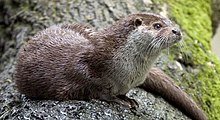
| |
| Eurasian otter (Lutra lutra) | |
| Scientific classification | |
| Domain: | Eukaryota |
| Kingdom: | Animalia |
| Phylum: | Chordata |
| Class: | Mammalia |
| Order: | Carnivora |
| Family: | Mustelidae |
| Subfamily: | Lutrinae Bonaparte, 1838 |
| Type genus | |
| Lutra Brünnich, 1771 | |
| Genera | |
|
Aonyx | |
Otters are carnivorous mammals in the subfamily Lutrinae. The 13 extant otter species are all semiaquatic, aquatic, or marine. Lutrinae is a branch of the Mustelidae family, which includes weasels, badgers, mink, and wolverines, among other animals.
Otters' habitats include dens known as holts or couches, with their social structure described by terms such as dogs or boars for males, bitches or sows for females, and pups or cubs for offspring. Groups of otters can be referred to as a bevy, family, lodge, romp, or raft when in water, indicating their social and playful characteristics. Otters are known for their distinct feces, termed spraints, which can vary in smell from freshly mown hay to putrefied fish.
Otters exhibit a varied life cycle with a gestation period of about 60–86 days, and offspring typically stay with their family for a year. They can live up to 16 years, with their diet mainly consisting of fish and sometimes frogs, birds, or shellfish, depending on the species. Otters are distinguished by their long, slim bodies, powerful webbed feet for swimming, and their dense fur, which keeps them warm and buoyant in water. They are playful animals, engaging in activities like sliding into water on natural slides and playing with stones.
There are 13 known species of otters, ranging in size and habitat preferences, with some species adapted to cold waters requiring a high metabolic rate for warmth. Otter-human interactions have varied over time, with otters being hunted for their pelts, used in fishing practices in southern Bangladesh, and occasionally attacking humans, though such incidents are rare and often a result of provocation. Otters hold a place in various cultures' mythology and religion, symbolizing different attributes and stories, from Norse mythology to Native American totems and Asian folklore, where they are sometimes believed to possess shapeshifting abilities.
Etymology
The word otter derives from the Old English word otor or oter. This and cognate words in other Indo-European languages ultimately stem from the Proto-Indo-European root *wódr̥, which also gave rise to the English word "water".
Terminology
An otter's den is called a holt, or couch. Male otters are called dogs or boars; females are called bitches or sows; and their offspring are called pups or cubs. The collective nouns for otters are bevy, family, lodge, romp (being descriptive of their often playful nature), or, when in water, raft.
The feces of otters are typically identified by their distinctive aroma, the smell of which has been described as ranging from freshly mown hay to putrefied fish; these are known as spraints.
Life cycle
The gestation period in otters is about 60 to 86 days. The newborn pup is cared for by the bitch, dog, and older offspring. Female otters reach sexual maturity at approximately two years of age and males at approximately three years. The holt is built under tree roots or a rocky cairn, more common in Scotland. It is lined with moss and grass.
After one month, the pup can leave the holt and after two months, it is able to swim. The pup lives with its family for approximately one year. Otters live up to 16 years; they are by nature playful, and frolic in the water with their pups. Its usual source of food is fish, and further downriver, eels, but it may sample frogs and birds.
Description
Otters have long, slim bodies and relatively short limbs. Their most striking anatomical features are the powerful webbed feet used to swim, and their seal-like abilities for holding breath underwater. Most have sharp claws on their feet and all except the sea otter have long, muscular tails. The 13 species range in adult size from 0.6 to 1.8 m (2.0 to 5.9 ft) in length and 1 to 45 kg (2.2 to 99.2 lb) in weight. The Asian small-clawed otter is the smallest otter species and the giant otter and sea otter are the largest. They have very soft, insulated underfur, which is protected by an outer layer of long guard hairs. This traps a layer of air which keeps them dry, warm, and somewhat buoyant under water.
Several otter species live in cold waters and have high metabolic rates to help keep them warm. Eurasian otters must eat 15% of their body weight each day, and sea otters 20 to 25%, depending on the temperature. In water as warm as 10 °C (50 °F), an otter needs to catch 100 g (3.5 oz) of fish per hour to survive. Most species hunt for three to five hours each day and nursing mothers up to eight hours each day.
Feeding
For most otters, fish is the staple of their diet. This is often supplemented by frogs, crayfish and crabs. Some otters are experts at opening shellfish, and others will feed on available small mammals or birds. Prey-dependence leaves otters very vulnerable to prey depletion. Sea otters are hunters of clams, sea urchins and other shelled creatures. They are notable for their ability to use stones to break open shellfish on their bellies. This skill must be learned by the young.
Otters are active hunters, chasing prey in the water or searching the beds of rivers, lakes or the seas. Most species live beside water, but river otters usually enter it only to hunt or travel, otherwise spending much of their time on land to prevent their fur becoming waterlogged. Sea otters are considerably more aquatic and live in the ocean for most of their lives.
Otters are playful animals and appear to engage in various behaviors for sheer enjoyment, such as making waterslides and sliding on them into the water. They may also find and play with small stones. Different species vary in their social structure, some being largely solitary, while others live in groups – in a few species these groups may be fairly large.
Species
|
Extant species
| Image | Genus | Species |
|---|---|---|

|
Lutra Brisson, 1762 |
|
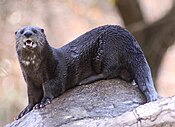
|
Hydrictis Pocock, 1921 |
|
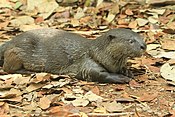
|
Lutrogale (Gray, 1865) |
|

|
Lontra Gray, 1843 |
|

|
Pteronura Gray, 1837 |
|
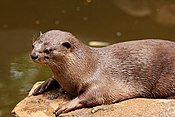
|
Aonyx Lesson, 1827 |
|
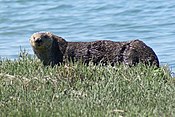
|
Enhydra Fleming, 1828 |
|
Extinct species
Subfamily Lutrinae
- Genus Lutra
- †Lutra castiglionis – Corsica, Pleistocene
- †Lutra euxena – Malta, Pleistocene
- †Japanese otter (Lutra nippon) – Japan, extinct c. 1979
- Genus Lutrogale
- Genus Enhydra
- Genus †Algarolutra – Corsica and Sardinia, Pleistocene
- Genus †Cyrnaonyx – Europe, Pleistocene
- Genus †Enhydriodon – Ethiopia, Late Miocene to Pliocene
- Genus †Enhydritherium – North America, Late Miocene to Early Pliocene
- Genus †Lutraeximia – Italy, Pleistocene
- Genus †Limnonyx – Germany, Late Miocene
- Genus †Megalenhydris – Sardinia, Pleistocene
- Genus †Paludolutra – Italy, Late Miocene
- Genus †Sardolutra – Sardinia, Pleistocene
- Genus †Siamogale – eastern Asia, Late Miocene to Early Pliocene
- Genus †Sivaonyx – Asia and Africa, Late Miocene to Early Pliocene
- Genus †Teruelictis – Spain, Late Miocene
- Genus †Torolutra – Africa, Pliocene
- Genus †Tyrrhenolutra – Italy, Late Miocene
- Genus †Vishnuonyx – Europe, Asia and Africa, Late Miocene to Early Pliocene
Relation with humans

Hunting
Otters have been hunted for their pelts from at least the 1700s, although it may have begun well before then. Early hunting methods included darts, arrows, nets and snares but later, traps were set on land and guns used.
There has been a long history of otter pelts being worn around the world. In China it was standard for the royalty to wear robes made from them. People that were financially high in status also wore them. The tails of otters were often made into items for men to wear. These included hats and belts. Even some types of mittens for children have been made from the fur of otters.
Otters have also been hunted using dogs, especially the otterhound. From 1958 to 1963, the 11 otter hunts in England and Wales killed 1,065 otters between them. In such hunts, the hunters notched their poles after every kill. The prized trophy that hunters would take from the otters was the baculum, which would be worn as a tie-pin.
Traffic (the wildlife trade monitoring network) reported that otters are at serious risk in Southeast Asia and have disappeared from parts of their former range. This decline in populations is due to hunting to supply the demand for skins.
Fishing for humans
Main article: Otter fishingFor many generations, fishermen in southern Bangladesh have bred smooth-coated otters and used them to chase fish into their nets. Once a widespread practice, passed down from father to son throughout many communities in Asia, this traditional use of domesticated wild animals is still in practice in the district of Narail, Bangladesh.
Attacks on humans
A 2011 review by the IUCN/SSC Otter Specialist Group showed that otter attacks reported between 1875 and 2010 occurred most often in Florida, where human and otter populations have substantially increased since 2000, with the majority involving the North American otter. At least 42 instances of attack were found, including one resulting in death and another case of serious injury. Attacking otters had rabies in 36% of anecdotal reports. 80% of otter bite victims do not seek medical treatment.
Animal welfare groups say that, unless threatened, otters rarely attack humans. In November 2021, about 20 otters ambushed a British man in his 60s during an early morning walk in Singapore Botanic Gardens. Despite weighing over 200 pounds, he was trampled and bitten and could not stand up without help from a nearby rescuer. The man speculated that another runner might have stepped on one of the animals earlier, and wished that there could be more lighting installed at that location.
Religion and mythology
Norse mythology tells of the dwarf Ótr habitually taking the form of an otter. The myth of "Otter's Ransom" is the starting point of the Volsunga saga.
In Irish mythology, the character Lí Ban was turned from a woman into a mermaid, half human and half salmon, and given three hundred years of life to roam the oceans. Her lapdog assumed the form of an otter and shared her prolonged lifetime and her extensive wanderings.
In some Native American cultures, otters are considered totem animals.
The otter is held to be a clean animal belonging to Ahura Mazda in Zoroastrian belief, and taboo to kill.
In popular Korean mythology, it is told that people who see an otter (soodal) will attract 'rain clouds' for the rest of their lives.
In the Buddhist Jataka tales, The Otters and The Wolf, two otters agreed to let a wolf settle their dispute in dividing their caught fish but it was taken away by the cunning wolf.
Japanese folklore
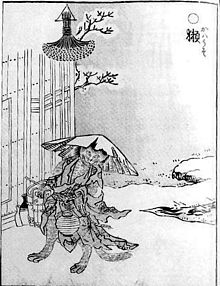
In Japanese, otters are called "kawauso" (獺、川獺). In Japanese folklore, they fool humans in the same way as foxes (kitsune) and tanuki.
In the Noto region, Ishikawa Prefecture, there are stories where they shapeshift into beautiful women or children wearing checker-patterned clothing. If a human attempts to speak to one, they will answer "oraya" and then answer "araya," and if anybody asks them anything, they say cryptic things like "kawai." There are darker stories, such as one from Kaga Province (now Ishikawa Prefecture) in which an otter that lives in the castle's moat shapeshifts into a woman, invites males, and then kills and eats them.
In the kaidan, essays, and legends of the Edo period like the "Urami Kanawa" (裏見寒話), "Taihei Hyaku Monogatari" (太平百物語), and the "Shifu Goroku" (四不語録), there are tales about strange occurrences like otters that shapeshift into beautiful women and kill men.
In the town of Numatachi, Asa District, Hiroshima Prefecture (now Hiroshima), they are called "tomo no kawauso" (伴のカワウソ) and "ato no kawauso" (阿戸のカワウソ). It is said that they shapeshift into bōzu (a kind of monk) and appear before passers-by, and if the passer-by tries to get close and look up, its height steadily increases until it becomes a large bōzu.
In the Tsugaru region, Aomori Prefecture, they are said to possess humans. It is said that those possessed by otters lose their stamina as if their soul has been extracted. They are also said to shapeshift into severed heads and get caught in fishing nets.
In the Kashima District and the Hakui District in Ishikawa Prefecture, they are seen as a yōkai under the name kabuso or kawaso. They perform pranks like extinguishing the fire of the paper lanterns of people who walk on roads at night, shapeshifting into a beautiful woman of 18 or 19 years of age and fooling people, or tricking people and making them try to engage in sumo against a rock or a tree stump. It is said that they speak human words, and sometimes people are called and stopped while walking on roads.
In the Ishikawa and Kochi Prefectures, they are said to be a type of kappa, and there are stories told about how they engage in sumo with otters. In places like the Hokuriku region, Kii, and Shikoku, the otters are seen as a type of kappa. In the Kagakushū, a dictionary from the Muromachi period, an otter that grew old becomes a kappa.
In an Ainu folktale, in Urashibetsu (in Abashiri, Hokkaido), there are stories where monster otters shapeshift into humans, go into homes where there are beautiful girls, and try to kill the girl and make her its wife.
In China, like in Japan, there are stories where otters shapeshift into beautiful women in old books like In Search of the Supernatural and the Zhenyizhi (甄異志).
See also
References
- ^ Koepfli KP, Deere KA, Slater GJ, et al. (2008). "Multigene phylogeny of the Mustelidae: Resolving relationships, tempo and biogeographic history of a mammalian adaptive radiation". BMC Biol. 6: 4–5. doi:10.1186/1741-7007-6-10. PMC 2276185. PMID 18275614.
- Geraads, Denis; Alemseged, Zeresenay; Bobe, René; Reed, Denné (2011). "Enhydriodon dikikae, sp. nov. (Carnivora: Mammalia), a gigantic otter from the Pliocene of Dikika, Lower Awash, Ethiopia". Journal of Vertebrate Paleontology. 31 (2): 447–453. Bibcode:2011JVPal..31..447G. doi:10.1080/02724634.2011.550356. S2CID 84797296.
- Switek, Brian. "The Bear Otter". Wired. Archived from the original on 26 August 2020. Retrieved 6 October 2017.
- "Otter". Merriam Webster's online dictionary. Archived from the original on 24 April 2009. Retrieved 16 September 2009.
- Harper, Douglas. "otter". Online Etymology Dictionary.
- Kruuk H (2007). Otters: ecology, behaviour and conservation. Oxford Biology. p. 7. ISBN 978-0-19-856587-1.
- "Species: Otter". The Mammal Society. Archived from the original on 25 May 2022. Retrieved 27 June 2022.
- M & P Briggs, The Natural History of British Isles, pp. 334–35
- "Facts about otters". Otter World. 5 March 2014. Archived from the original on 2 March 2016. Retrieved 1 January 2016.
- "Spraint Analysis". archive.today. Archived from the original on 8 September 2012. Retrieved 28 September 2017.
- Pagett, Matt (2007). What Shat That?: A Pocket Guide to Poop Identity. Ten Speed Press. ISBN 978-1-58008-885-5.
- Kruuk H (2007). Otters: ecology, behavior and conservation. Oxford Biology. pp. 99–116. ISBN 978-0-19-856587-1.
- "Tool use in otters". OneKind. Archived from the original on 4 November 2016. Retrieved 1 January 2016.
- Bininda-Emonds OR, Gittleman JL, Purvis A (1999). "Building large trees by combining phylogenetic information: a complete phylogeny of the extant Carnivora (Mammalia)" (PDF). Biol Rev Camb Philos Soc. 74 (2): 143–75. CiteSeerX 10.1.1.328.7194. doi:10.1017/S0006323199005307. PMID 10396181. Archived (PDF) from the original on 9 August 2017.
- Pereira, E.; Salotti, M. (2000). "Cyrnolutra castiglionis, une nouvelle forme de loutre (Mustelidae, Lutrinae), dans un dépôt du Pléistocène moyen " Castiglione 3CG "(Oletta, Haute-Corse)". Comptes Rendus de l'Académie des Sciences, Série IIA. 331 (1): 45–52. Bibcode:2000CRASE.331...45P. doi:10.1016/S1251-8050(00)00212-3.
- ^ Masseti, M. (1995). "Quaternary biogeography of the Mustelidae family on the Mediterranean islands". Hystrix. 7 (1–2): 17–34. CiteSeerX 10.1.1.536.8847.
- Mecozzi, B.; Iannucci, A.; et al. (2021). "Rediscovering Lutra lutra from Grotta Romanelli (southern Italy) in the framework of the puzzling evolutionary history of Eurasian otter". PalZ. 96: 161–174. doi:10.1007/s12542-021-00553-y. hdl:2434/891052. S2CID 232224971.
- Geraads, D.; Alemseged, Z.; et al. (2011). "Enhydriodon dikikae, sp. nov. (Carnivora: Mammalia), a gigantic otter from the Pliocene of Dikika, Lower Awash, Ethiopia". Journal of Vertebrate Paleontology. 31 (2): 447–453. Bibcode:2011JVPal..31..447G. doi:10.1080/02724634.2011.550356. S2CID 84797296.
- A. Berta and G. S. Morgan (1985). "A new sea otter (Carnivora: Mustelidae) from the late Miocene and early Pliocene (Hemphillian) of North America". Journal of Paleontology. 59 (4): 809–819. JSTOR 1304931.
- Cherin, M.; Iurino, D. A.; Willemsen, G.; Carnevale, G. (2016). "A new otter from the Early Pleistocene of Pantalla (Italy), with remarks on the evolutionary history of Mediterranean Quaternary Lutrinae (Carnivora, Mustelidae)". Quaternary Science Reviews. 135: 92–102. Bibcode:2016QSRv..135...92C. doi:10.1016/j.quascirev.2016.01.008.
- Morlo, M.; Nagel, D.; Bastl, K. (2020). "Evolution of the carnivoran (Carnivora, Mammalia) guild structure across the Middle/Upper Miocene boundary in Germany". Palaeogeography, Palaeoclimatology, Palaeoecology. 553: 109801. Bibcode:2020PPP...55309801M. doi:10.1016/j.palaeo.2020.109801. S2CID 219451746.
- Gerard F. Willemsen (2006). "Megalenhydris and its relationship to Lutra reconsidered" (PDF). Hellenic Journal of Geosciences. 41: 83–87. Archived (PDF) from the original on 6 March 2010.
- ^ Xiaoming Wang; et al. (2018). "A new otter of giant size, Siamogale melilutra sp. nov. (Lutrinae: Mustelidae: Carnivora), from the latest Miocene Shuitangba site in north-eastern Yunnan, south-western China, and a total-evidence phylogeny of lutrines". Journal of Systematic Palaeontology. 16: 39–65. Bibcode:2018JSPal..16...39W. doi:10.1080/14772019.2016.1267666. S2CID 58892181. Archived from the original on 4 December 2021. Retrieved 13 March 2022.
- ^ Kargopoulos, N.; Valenciano, A.; et al. (2021). "New early Late Miocene species of Vishnuonyx (Carnivora, Lutrinae) from the hominid locality of Hammerschmeide, Bavaria, Germany". Journal of Vertebrate Paleontology. 41 (3): e1948858. Bibcode:2021JVPal..41E8858K. doi:10.1080/02724634.2021.1948858. S2CID 240538139.
- Salesa (2014). "A non-aquatic otter from the Late Miocene". Zoological Journal of the Linnean Society. 169 (2): 448–482. doi:10.1111/zoj.12063.
- "Otter hunting". Otter-World.com. 2009. Archived from the original on 21 September 2013. Retrieved 19 September 2013.
- "Otter Hunting AKA Otter Hunting Begins – British Pathé". britishpathe.com. Archived from the original on 2 July 2017. Retrieved 28 September 2017.
- "Otterhunting". Animal Cruelty Investigation Group/Animal Welfare Information Service. Archived from the original on 21 September 2013. Retrieved 19 September 2013.
- "Otters feel the heat in Southeast Asia". Traffic (conservation programme). 9 December 2009. Archived from the original on 30 October 2013. Retrieved 17 January 2014.
- de Trey-White, Simon (2007). "Fisherman's friend". Geographical. 79 (5).
- Feeroz, M.M., Begum, S. and Hasan, M. K. (2011). "Fishing with Otters: a Traditional Conservation Practice in Bangladesh". Proceedings of XIth International Otter Colloquium, IUCN Otter Spec. Group Bull. 28A: 14–21. Archived from the original on 30 June 2017. Retrieved 20 June 2012.
{{cite journal}}: CS1 maint: multiple names: authors list (link) - Belanger, M (2011). "A review of violent or fatal otter attacks". IUCN Otter Spec. Group Bull. 28 (1): 11–16.
- Goldstein, Ellie J. C. (1 March 1992). "Bite Wounds and Infection". Clinical Infectious Diseases. 14 (3): 633–640. doi:10.1093/clinids/14.3.633. ISSN 1058-4838. PMID 1562653. Archived from the original on 15 March 2023. Retrieved 8 June 2022.
- ^ Lin, Chen (11 December 2021). "British man recounts attack by otters in Singapore gardens". Reuters. Archived from the original on 8 June 2022. Retrieved 8 June 2022.
- "The Otter's Ransom". faculty.mcla.edu. Archived from the original on 9 September 2006. Retrieved 5 July 2007.
- "Native American Indian Otter Legends, Meaning and Symbolism from the Myths of Many Tribes". native-languages.org. Archived from the original on 18 May 2015. Retrieved 6 May 2015.
- Cooper, JC (1992). Symbolic and Mythological Animals. London: Aquarian Press. pp. 171–72. ISBN 978-1-85538-118-6.
- "Otter Symbolism (6 Meanings) - As Spirit Animals & in Dreams". 12 December 2020. Retrieved 25 September 2023.
- Jataka Tales: The Otters and The Wolf https://mocomi.com/jataka-tales-the-otters-and-the-wolf/ Archived 30 September 2020 at the Wayback Machine
- 柳田國男 (1977) . 妖怪談義. 講談社学術文庫. 講談社. p. 19. ISBN 978-4-06-158135-7.
- ^ 村上健司編著 (2000). 妖怪事典. 毎日新聞社. p. 114. ISBN 978-4-620-31428-0.
- 水木しげる (1994). 妖怪大図鑑. 講談社まんが百科. 講談社. p. 59. ISBN 978-4-06-259008-2.
- ^ 柴田宵曲 (1991) . "続妖異博物館". In 木村新他編 (ed.). 柴田宵曲文集. Vol. 6. 小沢書店. p. 477.
- 藤井昭編著 (1976). 安芸の伝説. 第一法規出版. p. 166.
- ^ 内田邦彦 (1979) . 津軽口碑集. 歴史図書社. p. 126.
- 多田克己 (1990). 幻想世界の住人たち. Truth in Fantasy. Vol. IV. 新紀元社. p. 124. ISBN 978-4-915146-44-2.
- 村上健司 (2007). "河童と水辺の妖怪たち". In 講談社コミッククリエイト編 (ed.). DISCOVER 妖怪 日本妖怪大百科. KODANSHA Official File Magazine. Vol. 1. 講談社. p. 19. ISBN 978-4-06-370031-2.
- 香川雅信 (2012). "カッパは緑色か?". In 吉良浩一編 (ed.). 怪 (ムック). カドカワムック. Vol. 37. 角川書店. p. 34. ISBN 978-4-04-130038-1.
- 知里真志保 (1981) . "えぞおばけ列伝". アイヌ民譚集. 岩波文庫. 岩波書店. pp. 198–200. ISBN 978-4-00-320811-3.
External links
 The dictionary definition of otter at Wiktionary
The dictionary definition of otter at Wiktionary- IUCN SSC Otter Specialist Group
- ARKive Photographs and videos of Eurasian otters. On the same site are photos and videos of the marine otter (Lontra felina), sea otter (Enhydra lutris), smooth-coated otter (Lutrogale perspicillata) and giant otter (Pteronura brasiliensis).
- International Otter Survival Fund
| Taxon identifiers | |
|---|---|
| Lutrinae | |